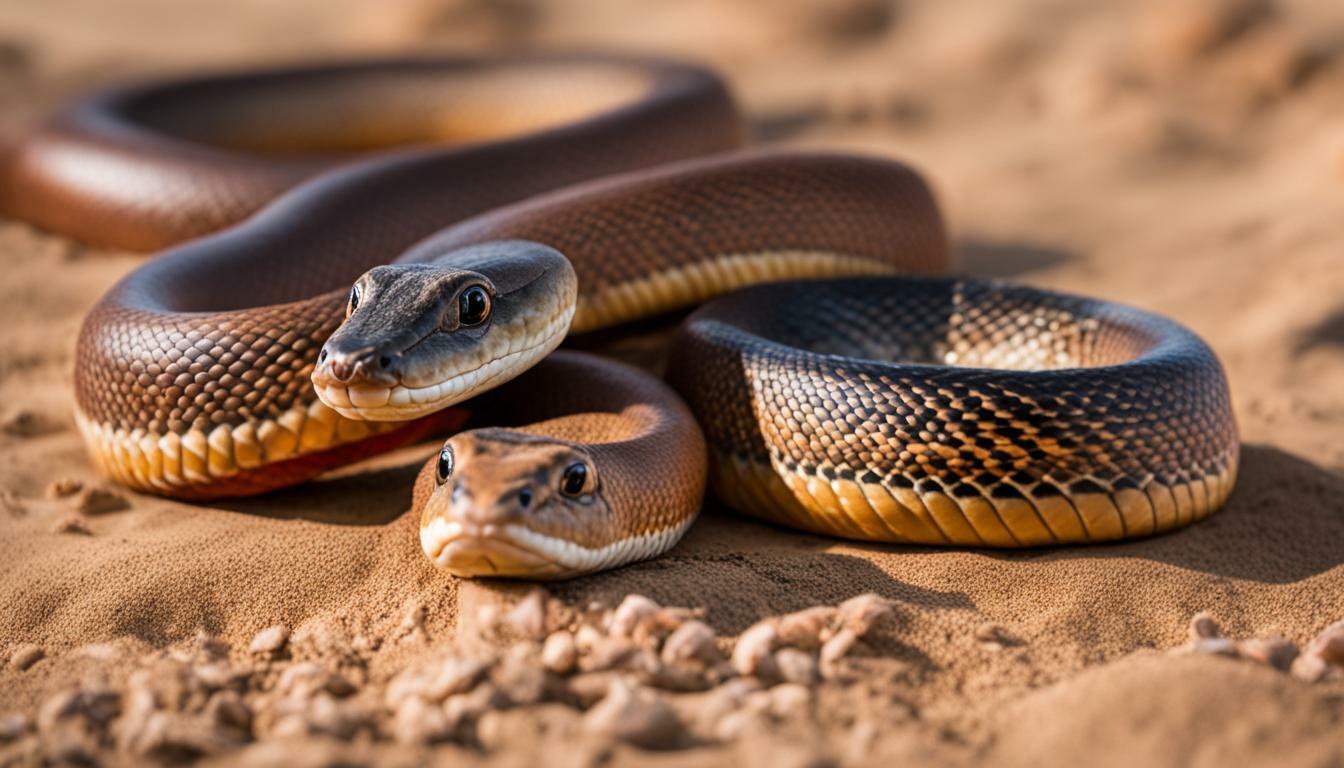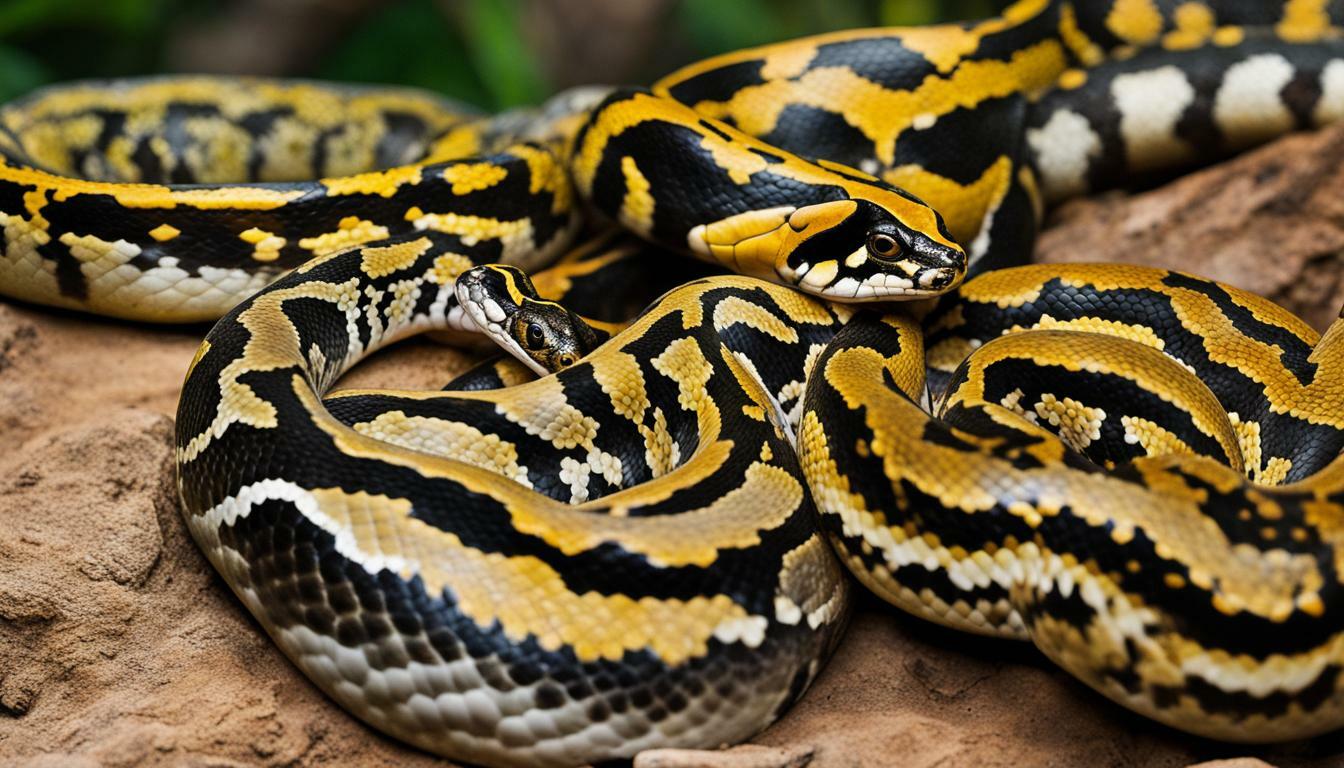If you’re a snake enthusiast or just have a passing interest in these fascinating creatures, you’ve probably heard of boas and pythons. While both are types of non-venomous snakes, they have distinct differences that set them apart.
In this article, we’ll take a closer look at boas and pythons, comparing and contrasting their physical characteristics, behavior, diet, habitat, defense mechanisms, size, and growth. By the end, you’ll have a better understanding of these two snake species and their unique adaptations.
Key Takeaways:
- Boas and pythons are two distinct species of non-venomous snakes
- Boas are more commonly found in the Americas and Africa, while pythons are found in Africa, Asia, and Australia
- Physical differences between boas and pythons include size, body shape, color patterns, and other notable characteristics
- Behavior and hunting techniques also differ between the two species of snakes
- Diet and preferred habitats are unique to each type of snake
- Boas and pythons have different defense mechanisms, including venom in some species
- Size and growth patterns vary between boas and pythons
Physical Characteristics
Boas and pythons are both large, muscular, and powerful snakes that belong to the same family, Boidae. However, there are several noticeable differences between these two species. While pythons have a more slender body, boas are heavier and have a more robust build. In terms of color and pattern, boas tend to have a more intricate pattern than pythons, with a distinct bold saddle pattern on their back. Pythons, on the other hand, have a smoother and more uniformed scale pattern.
When it comes to size, pythons are generally longer than boas, with some species reaching up to 33 feet in length. Boas, on the other hand, typically grow up to 13 feet in length. In terms of weight, boas are usually heavier than pythons, with some species weighing up to 250 pounds. Pythons can weigh up to 200 pounds, but most species range between 50-100 pounds.
Boa Characteristics
| Characteristic | Description |
|---|---|
| Scale texture | Boas have a smoother scale texture than pythons, with small keels running down the length of each scale. |
| Head shape | Boas have a more triangular-shaped head than pythons, with a larger and more angular supraocular bone. |
| Teeth | Boas have hooked teeth used for grabbing and holding onto prey. These teeth are located in the upper and lower jaw. |
Python Characteristics
| Characteristic | Description |
|---|---|
| Scale texture | Pythons have a rougher scale texture than boas, with larger keels running down the length of each scale. |
| Head shape | Pythons have a more rounded head than boas, with a smaller supraocular bone and a more prominent postocular bone. |
| Teeth | Pythons have backward-facing teeth used for pulling prey further into their mouth. These teeth are located only on the upper jaw. |
Overall, these physical differences make it relatively easy to identify whether you’re looking at a boa or a python, even at a glance. However, for inexperienced observers, it’s important to note that not all boas and pythons have the same physical characteristics, and some may display variations in color, pattern, and size within the species.
Behavior and Temperament
Boas and pythons have distinctive behaviors and temperament that separate them from each other. While both species are non-venomous and considered non-aggressive towards humans, their hunting techniques and defensive mechanisms differ.
Boas: Boas are ambush predators and use their powerful bodies to constrict their prey. They are typically slow-moving and prefer to avoid confrontation. However, when threatened, they will hiss loudly and strike, biting if necessary. Boas are also known for their docile nature and are often kept as pets.
Pythons: Pythons, on the other hand, are active hunters and use their keen senses to locate their prey. They are more aggressive than boas and will strike quickly when attacking. Pythons are also known for their ability to defend themselves by coiling their bodies around their attacker and squeezing. They are not typically kept as pets due to their more aggressive behavior.
While there are exceptions to these generalizations, understanding the typical behaviors and temperament of these two snake species can help us appreciate their unique adaptations to their environments.
Habitat and Natural Distribution
Boas and pythons have distinct habitats and geographic ranges. Boas are found throughout North, Central, and South America, where they reside in various ecosystems ranging from rainforests to deserts. Pythons, on the other hand, live in Africa, Asia, and Australia, where they inhabit a wide range of habitats, including forests, grasslands, swamps, and even deserts.
Boas are more adaptable than pythons and can tolerate a wider range of environments. They are found in both temperate and tropical regions, including the northernmost parts of North America. Pythons, however, are more restricted in their distribution and are endemic to certain regions. Some species of pythons, such as the reticulated and Burmese pythons, have become invasive in areas where they have been introduced.
Boas prefer to live in environments with high humidity and access to water sources. They are commonly found near rivers, streams, and wetlands. Pythons, on the other hand, can tolerate low humidity and have been known to live in arid regions.
In summary, while boas and pythons share some similarities in their natural distribution, they have significant differences in their habitat preferences and geographic range.
Diet and Feeding Habits
Boas and pythons have different dietary preferences and feeding habits. Boas are known to be generalist feeders, meaning they consume a variety of prey species. Their diet can range from small mammals, birds, and reptiles to larger animals, such as deer and wild pigs.
Pythons, on the other hand, are known to be specialist feeders. Depending on the species, they prefer to consume a specific type of prey. For example, the ball python primarily feeds on small rodents, while the reticulated python feeds on larger prey, such as deer and pigs.
Both boas and pythons are ambush predators, waiting for their prey to come within striking distance before attacking. Boas typically constrict their prey, using their powerful muscles to squeeze and suffocate them. Pythons, on the other hand, use their sharp teeth and powerful jaws to seize and swallow their prey whole.
After consuming their meal, both boas and pythons enter a period of digestion. During this time, they are not active and may even become more vulnerable to predators. It can take days or even weeks for them to fully digest and absorb their food.
Boas vs Pythons Diet: A Summary
| Boas | Pythons |
|---|---|
| Generalist feeders | Specialist feeders |
| Prey on a variety of species | Prefer a specific type of prey |
| Constrict their prey | Swallow their prey whole |
| Enter a period of digestion after eating | Also enter a period of digestion after eating |
Defense Mechanisms and Venom
Boas and pythons have evolved a range of defense mechanisms to protect themselves from predators. Some of the most common mechanisms include biting, hissing, and coiling around their attacker. Boas and pythons also have the ability to camouflage themselves, making it difficult for predators to spot them.
When it comes to venom, it is important to note that not all snakes produce venom, and those that do have varying degrees of toxicity. Boas are non-venomous snakes, meaning they do not produce venom, while pythons are also not known to be venomous. However, some species of pythons have been found to contain trace amounts of venom in their saliva.
It is important to note that just because a snake is non-venomous, it does not mean it is harmless. Large constrictor snakes like boas and pythons are incredibly strong and can cause serious harm to their prey or handlers if not handled properly.
Size and Growth
Boas and pythons differ significantly in size, with pythons typically being larger than boas. The longest snake in the world is the reticulated python, which can reach lengths of up to 30 feet. In comparison, the largest boa species, the green anaconda, maxes out at around 17-18 feet in length.
While both boas and pythons start out as small hatchlings, pythons tend to grow faster and larger than boas. This is largely due to the fact that pythons have a higher metabolism and are more active in finding and consuming prey. In comparison, boas are more sedentary, which means they don’t need to eat as frequently to sustain their energy needs.
As hatchlings, both boas and pythons are roughly the same size, usually measuring between 10-18 inches in length. Over time, pythons grow at a faster rate than boas and can reach up to 6-8 feet in length within their first year of life. Boas, on the other hand, typically grow at a slower pace and may take up to 3-4 years to reach the same length.
Despite their differences in size and growth patterns, both boas and pythons have the potential to live for several decades in captivity if they are provided with appropriate care and living conditions.
Conclusion
By contrasting boas and pythons, it is evident that these two snake species have distinct physical characteristics, behaviors, habitats, diets, and defensive mechanisms. Boas and pythons are both fascinating and unique creatures that have evolved to thrive in varying environments across the globe.
As you have learned, boas and pythons differ in many ways, including their size, shape, color patterns, hunting techniques, metabolism, growth patterns, and venom. Understanding these distinctions contributes to our appreciation of the diverse world of snakes and their unique adaptations.
Whether you have a passion for snake conservation, or simply appreciate the beauty of these creatures, understanding the differences between boas and pythons will enhance your knowledge of the animal kingdom.
FAQ
Q: What is the difference between boas and pythons?
A: Boas and pythons are both types of snakes, but they belong to different families. Boas are members of the Boidae family, while pythons belong to the Pythonidae family. They differ in physical characteristics, behavior, habitat, and diet.
Q: What are the physical characteristics of boas and pythons?
A: Boas and pythons have distinct physical attributes. Boas are generally shorter and stockier, while pythons are longer and more slender. They also have different color patterns and scale textures.
Q: How do boas and pythons behave?
A: Boas and pythons have unique behavioral traits. Boas tend to be more docile and relaxed, while pythons are known for their aggressiveness. They have different hunting techniques and interact with their environment and prey in varying ways.
Q: Where can boas and pythons be found?
A: Boas and pythons have different preferred habitats and natural distributions. Boas are found in various regions of the world, including the Americas, while pythons are primarily found in Africa, Asia, and Australia.
Q: What do boas and pythons eat?
A: Boas and pythons have different dietary preferences and feeding habits. Boas typically feed on small mammals, birds, and reptiles, while pythons are known for their ability to consume larger prey, including mammals and even other reptiles.
Q: Do boas and pythons have venom?
A: While some boas and pythons have mild venom, it is not as potent as venom found in venomous snakes. They rely more on constriction to subdue their prey.
Q: How big do boas and pythons grow?
A: Boas and pythons have different growth patterns. Boas generally reach smaller sizes, with average lengths ranging from 4 to 10 feet. Pythons, on the other hand, can grow much larger, with some species reaching lengths of over 20 feet.
 Skip to main content
Skip to main content


